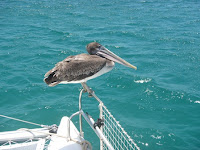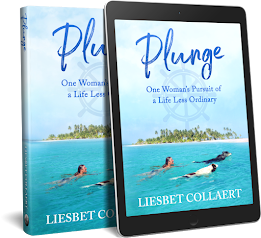


 The other day, Mark and I wanted to set out for a walk along the shore line, starting at San Cristobal's naval base. On the map it was marked as a trail to two surfing spots (did you know that the Galapagos are a popular surfing destination?); it seemed like good exercise with possibly some nice views along the way. Before we even got to the base, we enjoyed watching the resident sea lions do their thing on the town's beach. A pup was stubbornly trying to drink its mother's milk, when we saw it.... The little one had a yellow rope, line or ribbon pressing into the fur of its neck. It wouldn't take too long for a bigger problem to arise. Putting on a few more pounds could cause it to be uncomfortable or even choke.
The other day, Mark and I wanted to set out for a walk along the shore line, starting at San Cristobal's naval base. On the map it was marked as a trail to two surfing spots (did you know that the Galapagos are a popular surfing destination?); it seemed like good exercise with possibly some nice views along the way. Before we even got to the base, we enjoyed watching the resident sea lions do their thing on the town's beach. A pup was stubbornly trying to drink its mother's milk, when we saw it.... The little one had a yellow rope, line or ribbon pressing into the fur of its neck. It wouldn't take too long for a bigger problem to arise. Putting on a few more pounds could cause it to be uncomfortable or even choke.
 It was getting hot when we arrived at the gated military zone, where we were denied access to the trail. Mark and I had a sneaking suspicion we wouldn't be able to pass through the naval base to do the hike. The trail is apparently off limits and one wonders why it is marked on the map. The base has been around for ages. We were all packed and prepared for a day trip (except for Mark forgetting his swim trunks), so we decided to head back to La Loberia, a beach and sea lion colony a few miles east of town. We had a sweaty walk there a few days prior and were disappointed with the absence of sea life. This time, we took a taxi ($1 p.p.) to the site, hoped it was higher tide and planned to explore the area past the beach.
It was getting hot when we arrived at the gated military zone, where we were denied access to the trail. Mark and I had a sneaking suspicion we wouldn't be able to pass through the naval base to do the hike. The trail is apparently off limits and one wonders why it is marked on the map. The base has been around for ages. We were all packed and prepared for a day trip (except for Mark forgetting his swim trunks), so we decided to head back to La Loberia, a beach and sea lion colony a few miles east of town. We had a sweaty walk there a few days prior and were disappointed with the absence of sea life. This time, we took a taxi ($1 p.p.) to the site, hoped it was higher tide and planned to explore the area past the beach.

 Taking the cab was a treat, and a great decision! Our energy and sweat was saved for the more important and interesting part of the morning. We passed La Loberia beach after ten minutes of walking - still barely any sea lions - and moved further afield, following a rocky trail, which soon turned into clambering the volcanic rocks. Wearing shoes would have helped... After a half hour of strenuous activity, getting startled by a few camouflaged marine iguanas, and liters of sweat, we reached a high cliff. The view was all right, but the blue-footed boobies and other sea birds were the attraction. Undisturbed by our presence, they posed for the picture and roosted in the rocky crevasses.
Taking the cab was a treat, and a great decision! Our energy and sweat was saved for the more important and interesting part of the morning. We passed La Loberia beach after ten minutes of walking - still barely any sea lions - and moved further afield, following a rocky trail, which soon turned into clambering the volcanic rocks. Wearing shoes would have helped... After a half hour of strenuous activity, getting startled by a few camouflaged marine iguanas, and liters of sweat, we reached a high cliff. The view was all right, but the blue-footed boobies and other sea birds were the attraction. Undisturbed by our presence, they posed for the picture and roosted in the rocky crevasses. Once back down at the beach, we rested in the only shade to be found. We had lunch, watched some surfers, some red and black crabs and a couple of sea lions, before I decided to go for a snorkel. Last time, the shallow water was freezing and my underwater camera couldn't handle the huge change in temperature. Plus, there was “nothing” to see in the protected bay. Mark wished me luck with the "grey fish" and the icy Humboldt current, before picking me up to go home a bit later. Little did he know about what he was missing out on by not bringing his swim shorts... From the moment I entered the pleasantly refreshing water, I saw a multitude of colorful fish and bright green rocks. A big black ray was feasting on something and I observed it for a bit, before following it up close. While filming its movement, the camera spotted a big sea turtle resting on the bottom. And another one. And three more. Distracted by the new sight, I had to get back to the ray later. All these animals have no fear of human beings and, with the swell rolling back and forth, it is almost hard not to bump into them!
Once back down at the beach, we rested in the only shade to be found. We had lunch, watched some surfers, some red and black crabs and a couple of sea lions, before I decided to go for a snorkel. Last time, the shallow water was freezing and my underwater camera couldn't handle the huge change in temperature. Plus, there was “nothing” to see in the protected bay. Mark wished me luck with the "grey fish" and the icy Humboldt current, before picking me up to go home a bit later. Little did he know about what he was missing out on by not bringing his swim shorts... From the moment I entered the pleasantly refreshing water, I saw a multitude of colorful fish and bright green rocks. A big black ray was feasting on something and I observed it for a bit, before following it up close. While filming its movement, the camera spotted a big sea turtle resting on the bottom. And another one. And three more. Distracted by the new sight, I had to get back to the ray later. All these animals have no fear of human beings and, with the swell rolling back and forth, it is almost hard not to bump into them! Hanging out with the sea lions on the town's benches
Marine Iguana soaking up the sun at La Loberia
Blue-footed Booby
Swallow-tailed Gull
Nazca Booby
Mark posing next to the Blue-footed Booby he took pictures of - they are not shy
Another kind of sea urchin in these waters...






































































